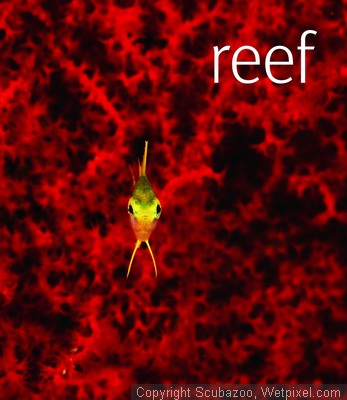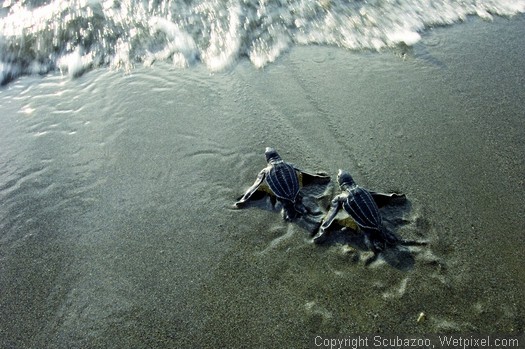Review of Reef by Scubazoo

In the 1950s and 1960s, David Brower put the Sierra Club on the map and raised the environmental consciousness of a generation by investing in the publication of a series of high quality photo books of some of the most beautiful and threatened environments in the world.
Brower understood that people will protect what they love, and his books were the eloquent pleas of a suitor trying to get people to fall in love with and fight for the natural world. The effort was at least partially successful in parts of the dry portions of the planet; since the 1960s, millions of acres of American land have been preserved as wilderness, much of it in Alaska, with the political, emotional and financial support of millions of Americans who will never see the land they came to care so much about.
Throughout the same period, the wet portions of the planet, more vast by far than all the mountains and deserts of the world, have suffered the most rapid and severe deterioration seen on Earth since the extinction of the dinosaurs. The difference, of course, is that the collapse of the oceans was preventable by humans. With determination and a little luck, some of it might still be reversible. Success will depend largely on the willingness of people to fight for something that many of them will never see first-hand.
That is the goal of a unique enterprise known as Scubazoo, a team of mostly British underwater photographers and videographers “who have an intense love and appreciation of the marine world,” as they describe themselves on their website. Having produced numerous films and videos and provided footage for many others, the Borneo-based team has just come out with their second coffee table book, “Reef,” an ambitious 360-page hardcover collection of stunning photographs and topical essays on reef life and the threats facing tropical reefs today.
Scubazoo is just a team of image-makers, not a marine version of the Sierra Club, but this book aims for a global audience to create a greater awareness that “we have no choice but to find new, sustainable ways of harvesting our oceans before it’s too late,” in the words of founder and CEO Simon Christopher. “We hope that by sharing our pictures in this book we can foster real appreciation for the world’s reefs and help communicate the urgent need for their conservation and preservation.”
To reinforce Scubazoo’s commitment, the publisher notes that portions of the price of every book sold will be donated to the Coral Reef Alliance.
Following a heavyweight introduction from venerable oceanographer Sylvia Earle, “Reef” presents its subject in a series of thematic chapters: “Seascapes,” “Diversity,” “Survival,” and “Conserving Reefs.” The chapter on survival, being the heart of reef life and of the message of the book, is further subdivided into “Predator,” “Arms and Armor,” “Deception,” “Schooling,” “Symbiosis,” and “Life Cycles.”
This is primarily a picture book. Each chapter has a brief introductory essay outlining the theme, followed by pages of well-captioned images and short quotes from the photographers about some of their most memorable underwater encounters. The photos themselves, from microscopic macros to wide-angle wet vistas, are excellent and well presented throughout. The anecdotes are interesting and will keep the veteran diver’s interest.

The photos were taken by five different members of the Scubazoo team, though the bulk are by Scubazoo Co-Founder Jason Isley and Publications Director Matthew Oldfield. Senior Cameraman Roger Munns added a fair number, and team members Seok Wun Au Yong and Adam Broadbent each contributed a handful. The result is what you would expect from a team effort of this kind – a diversity of styles and skills, appealing to broad audiences as Scubazoo aims to do.
While loaded with biodiversity and a wide range of appropriate reef themes, this book suffers from a significant lack of geographic diversity. There are less than half a dozen photos from the Caribbean or the Atlantic – most of those from Brazil.
To be sure, the Indonesian Archipelago where most of the photos were taken is home to the greatest number of spectacular image possibilities, and it would be hard to argue against a book solely on that corner of the world ocean (in fact Scubazoo’s first book, “Sipadan, Mabul, Kapalai Sabah’s Underwater Treasure” was exactly that), but this book explicitly aims wider, hoping to protect “the world’s reefs.”
But by focusing almost entirely on the Indo-Pacific region, “Reef” seems to suggest that outside of that spectacular corner of the ocean, there’s really not that much to see. This error is compounded in the first of a series of appendices, “Coral Reefs of the World,” where the Caribbean is represented by an aerial photo of Belize’s Blue Hole, which many divers can attest is an interesting but largely sterile underwater sinkhole. It’s too bad the book didn’t include some of the spectacular sponges and their macro inhabitants on the walls of nearby Lighthouse reef.

If the aim is to convince the uninitiated to fall in love with and protect the world’s reefs, it is best to start by showing them what’s in their own backyards. They may be awed by the exotic animals and scenes on the far side of the world, but will they fight to protect it? Americans fought to protect remote Alaskan wilderness only after they had come to value the wilderness within easy driving distance.
“Reef” comes with a bonus – a 30-minute DVD of video footage organized just like the book. In some cases, these images are more powerful than the book, particularly the “Conservation” chapter, with haunting footage of reefs being subjected to explosives and poison for harvesting, and boat decks covered with by-catch destined to become dead jetsam. The video has a musical soundtrack, but no narration or captions, so it should be regarded as a supplement to the book.
Even with its geographic weakness, “Reef” will make a good gift for divers or for non-divers with an interest in marine conservation. Through those readers, it may find the broader audience it seeks, if it’s passed on with the reminder that we have important reefs close to home, too. It’s a terrific effort, and terrific efforts are just what the ocean needs right now.
“Reef,” by Scubazoo, foreword by Sylvia Earle, published by DK, September 2007
-George Cathcart